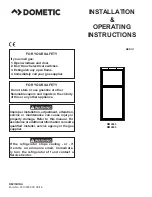
5
ABNORMAL OPERATION
Any of the following are considered to be abnormal opera-
tion and may require servicing:
•
Yellow tipping of the burner flame.
•
Sooting up area surrounding burner.
•
Burner not igniting properly.
•
Burner fails to remain lit.
In case the appliance fails to operate correctly, contact an
authorized Dometic Service Center.
230-240V OPERATION
When a mains connection is available, AES will select
this. Please note, that even being in AC mode, 12V DC is
necessary for the internal supply of the electronics.
12V OPERATION
AES will select the 12V mode of operation as soon as the
vehicle engine is running (detected by the alternator con-
nection of the fridge D+).
If the 12V DC goes down below 9V DC, the system will
shut down completely.
SWITCHING BETWEEN ENERGY
SOURCES
When switching from one energy source to another, there
are some delays implemented in the AES system. The
15 minute delay between switching off the engine and
starting gas mode is intended to delay the starting of gas
mode, e.g., when stopping at a filling station.
TRAVEL CATCH
Make sure that the travel catch is engaged when the mo-
tor home / caravan is on the move.
USING THE REFRIGERATOR
REGULATING THE TEMPERATURE
The position number refers to Fig.1.
It will take a few hours for the refrigerator to reach normal
operating temperature. So we suggest you start it well in
advance of a trip and if possible store it with precooled
foodstuffs.
The temperature of the refrigerator main compartment is set
for all three sources of energy by means of the Tempera-
ture selector button (
3
). After turning on the refrigerator
the system automatically chooses the mid-position. With
some experience you will soon find a suitable setting,
bigger circles indicate lower temperatures. This normally
does not need resetting because the same thermostat
controls the main compartment temperature for any of the
three sources of energy.
FOOD STORAGE
Always keep food in closed containers. Never put hot
food in the refrigerator; allow it to cool first.
The frozen food compartment is intended for the storage
of frozen food and for making ice. Most kinds of frozen
food can be stored in the frozen food compartment for
about a month. This period of time may vary, however,
and it is important to follow the instructions on the indi-
vidual packages.
ICE MAKING
Fill the ice tray to just below the brim with drinking water
and place them on the bottom of the freezer compartment.
Ice will be made more rapidly if the thermostat is set at its
highest position (biggest circle), but be sure to move the
thermostat back to normal setting when the ice is formed;
the refrigerator might otherwise become too cold.
DEFROSTING
Frost will gradually accumulate on the refrigerating sur-
faces. Each time the door is opened some of the cold air
in the refrigerator spills out and is replaced by warm moist
room air. As this air is cooled, the moisture is deposited
onto the evaporator coils or other cold surfaces inside the
refrigerator and can cause frost build-up.
It is important that you do not leave the unit’s door open
any longer than necessary. This will reduce frost forma-
tion and increase the efficiency of your refrigerator.
The frost must not be allowed to grow too thick as it acts
as an insulator and adversely affects refrigerator perform-
ance. Check the formation of frost regularly every week
and when it gets about 3 mm thick, defrost the refrigera-
tor.
Do not try to accelerate defrosting by using
any kind of heating appliance, as this might
damage the plastic surfaces of the refrigerator.
Neither should any sharp objects be used to
scrape off the ice.
z
P
It is not allowed to have an open flame at a gas filling
station. If you are not sure, that your stop is shorter
than 15 minutes, you are advised to set the ON/OFF
switch (1) to “OFF”, when stopping at a filling station.
DO NOT store explosive substances in the refrigerator,
such as cigarette lighter gas, gasoline, ether or the like.


































